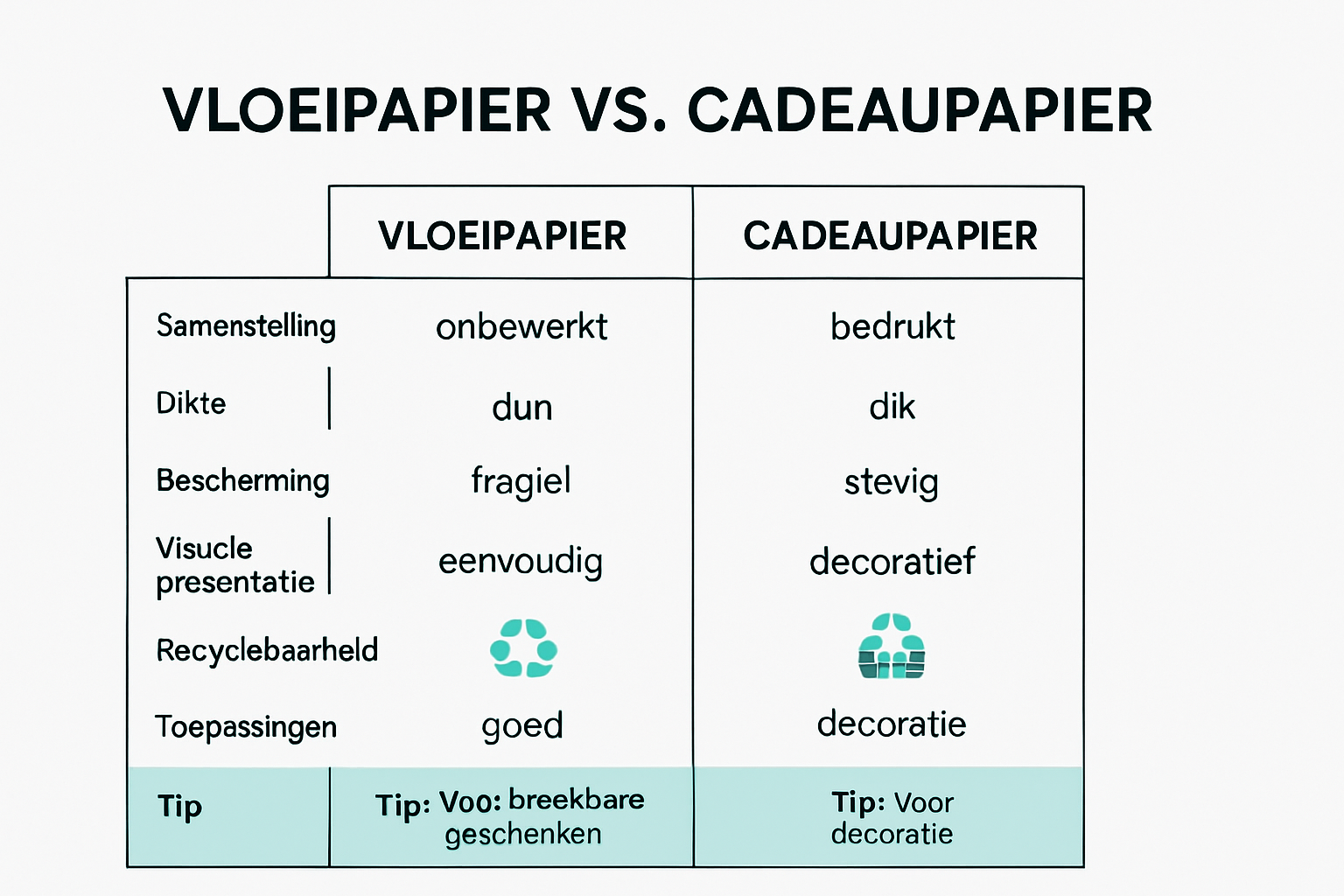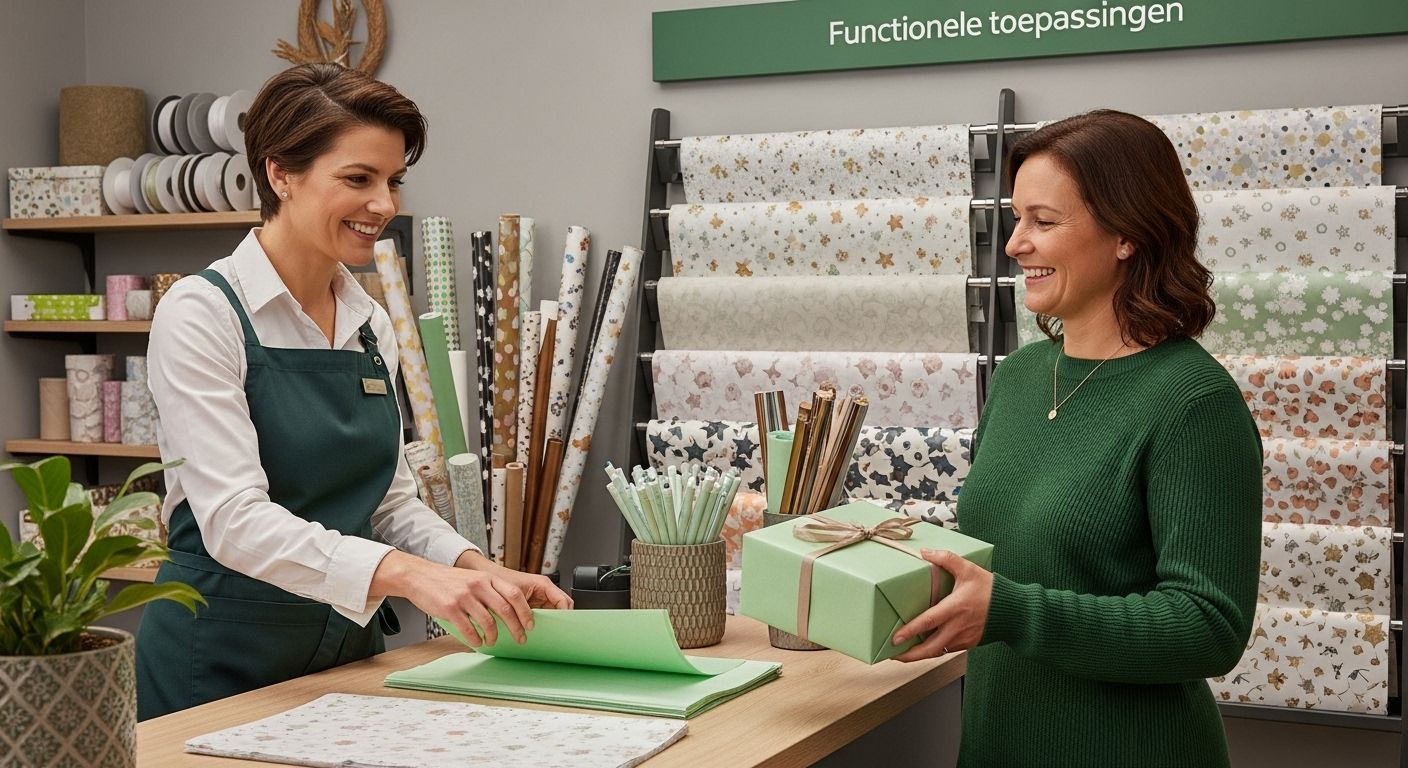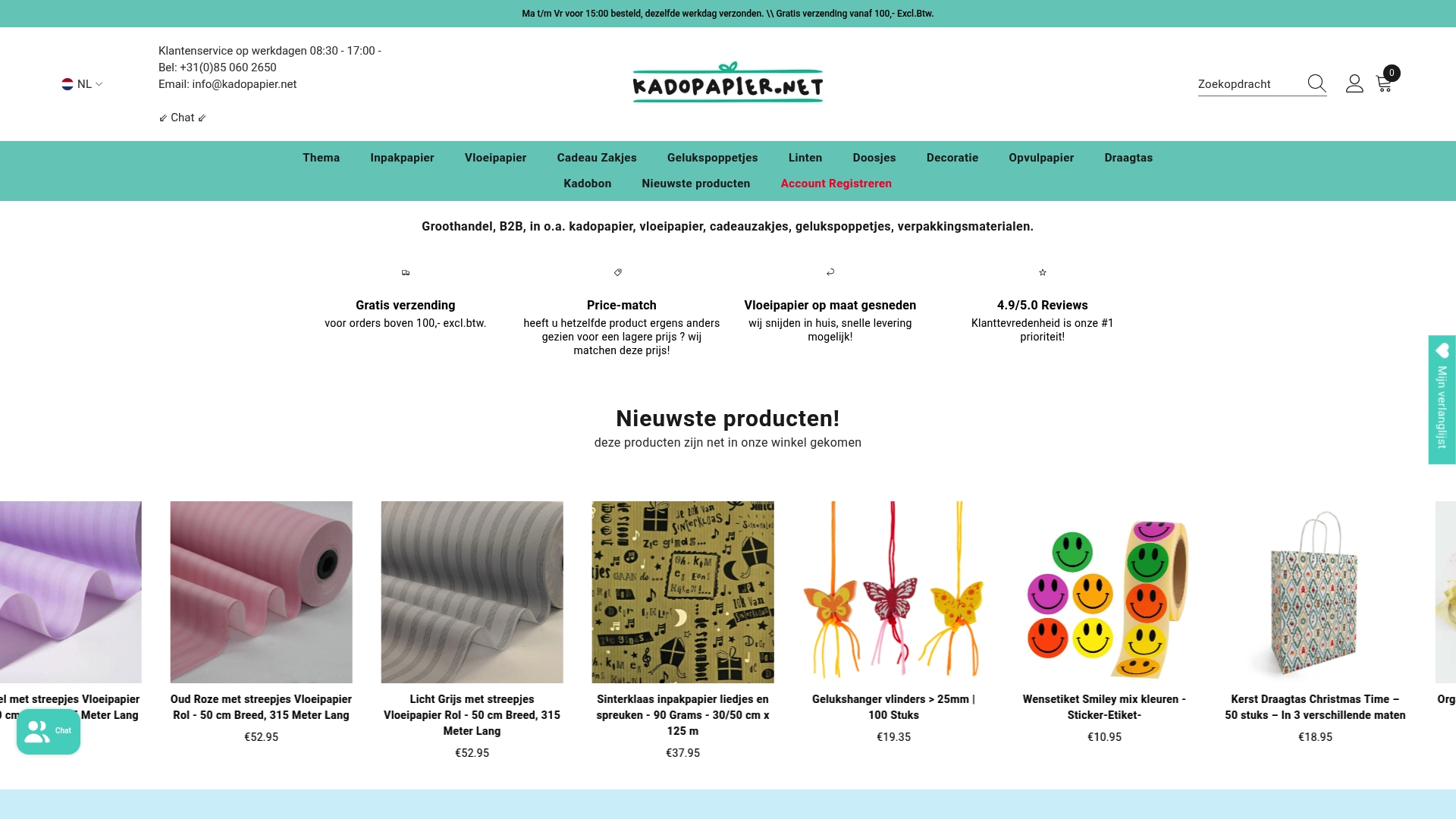Difference between tissue paper and gift wrapping paper: everything you need to know

Tissue paper and wrapping paper seem simple at first glance, but they make a world of difference when wrapping gifts and products. Most people blindly choose wrapping paper because it stands out with its bright colors and glossy prints. And guess what? Tissue paper is becoming increasingly popular because of its softness and compostability, especially when wrapping delicate or sustainable gifts.
Table of contents
- What is tissue paper and when do you use it?
- Features and uses of wrapping paper
- Key differences between tissue paper and wrapping paper
- Which paper choice suits your needs?
Summary
| Take with you | Explanation |
|---|---|
| Choose between tissue paper and gift wrapping paper | Depending on the application and protection, choose the right paper. Tissue paper is soft and flexible, while gift wrapping paper offers strength. |
| Tissue paper is ideal for delicate objects | It provides soft protection for fragile objects and can also be used creatively in decorations. |
| Wrapping paper has a visual impact | The choice of pattern and color in wrapping paper creates a strong first impression and enhances the aesthetics of the gift. |
| Consider environmental impact when choosing paper | Tissue paper is often compostable, while wrapping paper with glitter is less environmentally friendly. |
| Combine both types of paper for optimal effect | By using tissue paper and wrapping paper together you create both protection and an attractive presentation. |
What is tissue paper and when do you use it?
Tissue paper is an exceptionally versatile material that offers far more possibilities than many people realize. It's a thin, soft, and slightly translucent paper that was originally developed for protective and packaging purposes, but has since become an indispensable part of gift wrapping, decorations, and creative projects.
The origin and properties of tissue paper
Tissue paper stands out for its unique properties. It is extremely thin, light, and soft, making it ideal for wrapping fragile items. Research into packaging materials shows that tissue paper is an economical alternative to bubble wrap for protecting fragile items during storage or moving.
The composition of tissue paper also makes it particularly suitable for various applications. It is made of short fibers, which gives it a characteristically soft and supple texture. These properties make it not only practical for protection but also perfect for decorative purposes such as creating flowers, ornaments, and even art projects.
Practical applications of tissue paper
Tissue paper is widely used in various contexts. In gift wrapping, it's essential for beautifully and neatly wrapping gifts, adding volume and an elegant finish. It also protects fragile or delicate items from scratches and damage.
Beyond gift wrapping, tissue paper also has environmental considerations. Ecology researchers suggest that tissue paper should preferably be composted rather than recycled, as it is made from shortened fibers. It's important to note that tissue paper with glitter should be disposed of with general waste.
Discover more creative ways to use tissue paper for inspiration on your next project. Whether you want to wrap a gift, create decorations, or protect delicate items, tissue paper is a versatile solution that can meet a variety of needs.
For professionals in retail, event management, or the creative industries, tissue paper is an indispensable tool. It not only offers practical protection but also contributes to the aesthetic presentation of products and gifts. Its light weight and soft texture make it a superior choice for countless applications.
Features and uses of wrapping paper
Wrapping paper is a dynamic and versatile material that's more than just a wrapping for gifts. It creates a crucial first impression and contributes to the overall presentation and experience of a gift.
Composition and production process
The wrapping paper production process is a sophisticated technique that begins with wood pulp, primarily sourced from softwood trees. Industry research reveals that the pulp is bleached to achieve a clean, bright appearance. Today, there's a growing emphasis on environmental friendliness, which has led to the use of recyclable paper and eco-friendly inks.
The production of wrapping paper involves advanced printing techniques such as rotogravure and flexography. Production methods allow for special finishes, such as foil stamping, iridescent, pearlescent, and flocked effects, which significantly enhance visual appeal.
Technical properties and applications
Different types of wrapping paper are characterized by their weight and density, measured in GSM (grams per square meter). Technical specifications indicate that paper with a GSM between 17 and 20 is particularly light and delicate, ideal for wrapping delicate items or adding a soft touch to gift bags.
The translucent quality of some wrapping paper offers a subtle elegance to presentations. Professionals in retail, gift wrapping, and event organization appreciate the versatility of wrapping paper for both practical and aesthetic purposes.
Discover our creative wrapping tips to take your gift wrapping skills to the next level. Whether you're wrapping an elegant corporate gift or a personal present, the right choice of wrapping paper can make the difference between a standard gift and an unforgettable one.
Wrapping paper is more than just packaging; it's a form of expression, a way to convey appreciation, care, and attention. The choice of color, pattern, and texture tells a story before the gift is even opened. It creates a visual and tactile first impression that the recipient will remember.
Key differences between tissue paper and wrapping paper
Tissue paper and gift wrapping paper are often used interchangeably, but they have fundamentally different properties, applications, and characteristics that make them unique. Understanding these nuances is crucial for professionals and consumers seeking the ideal packaging solution.
To help you quickly see the main differences between tissue paper and wrapping paper, here's a comparison table that summarizes their key properties, usages, and environmental impact:
| Feature | Tissue Paper | Wrapping Paper |
|---|---|---|
| Material Composition | Recycled pulp or wood fibers | Wood pulp from softwood trees |
| Texture & Structure | Very soft, thin, and flexible | Firmer, more structured |
| Typical Uses | Protecting delicate/fragile items, decorative accents, craft projects | External wrapping, visual presentation, gift wrapping |
| Finish & Appearance | Light, translucent, rarely glossy | Can be glossy, patterned, or metallic |
| Environmental Considerations | Often compostable (unless glittered) | Hard to recycle if metallic or with glitter; some recyclable types exist |
| Ideal for | Fragile items, adding volume to gifts | Visual impact, durable wrapping |

Composition and Material
Research into paper materials reveals that tissue paper is made from recycled paper pulp or wood fibers. It is characterized by an extremely light and thin structure with a soft, translucent texture. In contrast, wrapping paper is made from softwood pulp, often bleached for a bright and crisp appearance.
The fundamental difference in composition results in varying properties. Tissue paper is exceptionally soft and flexible, while gift wrapping paper offers more strength and structure. These property differences determine their specific uses in different contexts.
Functional Applications and Recyclability
Regarding environmental considerations, there are significant differences. Environmental research shows that many wrapping paper types with metallic finishes, glitter, or special embellishments are not recyclable due to their complex material composition. However, some types of wrapping paper can be recycled.
Tissue paper has other recycling options. Composting is recommended due to its short fiber structure. However, glitter tissue paper should be disposed of with general waste. See our guide to proper packaging and recycling for more detailed information on eco-friendly packaging choices.
In practice, tissue paper and gift wrap are often used in a complementary way. Tissue paper acts as a protective, soft layer inside boxes or gift wrapping, while gift wrap forms the outer, decorative layer. This combination maximizes both protection and aesthetic appeal.

For professionals in retail, gift wrapping, and the creative industries, it's essential to understand the subtle nuances between these materials. The choice between tissue paper and gift wrap depends on specific requirements such as product fragility, desired presentation, transportation conditions, and environmental considerations.
Ultimately, it's all about choosing the right material that's not only functional but also suits the nature of the gift or product and the desired look. Whether you're packaging a delicate piece of jewelry or a robust decorative item, understanding the properties of tissue paper and wrapping paper will allow you to make a well-informed choice.
Which paper choice suits your needs?
Choosing the right paper for packaging or presentation is more than just a superficial decision. It requires careful consideration of various factors that ultimately determine the effectiveness and appeal of your gift or product.
Factors for Choosing the Right Paper
Research from the Oregon State University Extension Service emphasizes that paper choice depends on texture, strength, and decorative appeal. Tissue paper is distinguished by its flexibility and softness, making it ideal for wrapping delicate items and creating a soft protective layer. Gift wrapping paper, on the other hand, offers more structural support and visually appealing patterns.
When selecting the right paper, consider the specific characteristics of the item you want to wrap. Fragile or breakable items require the soft protection of tissue paper, while more robust items benefit from the strength of wrapping paper.
Application-Oriented Considerations
For professionals in retail, gift wrapping, and the creative industries, paper selection is crucial. A piece of jewelry, for example, requires a different packaging approach than a book or electronic device. Discover our guide to creative packaging techniques to broaden your understanding of the art of perfect wrapping.
Environmental considerations also play a significant role. Recycled paper is gaining popularity for sustainable packaging solutions. Be aware of special properties such as glitter or metallic finishes, which can affect recyclability.
When choosing between tissue paper and gift wrap, you should also consider the aesthetic presentation. Tissue paper can be used to create extra volume and softness, while gift wrap provides a sleek and professional finish. Combine both for optimal results.
For crafters, decorators, and shop owners, understanding these nuances is essential. Whether you're wrapping a delicate work of art, presenting a luxury product, or creating seasonal decorations, the right paper choice can make the difference between standard and memorable packaging.
Ultimately, it's all about finding the perfect balance between functionality, protection, and aesthetics. Experiment with different paper types, combine textures, and consider the specific requirements of your project. A well-considered paper choice not only enhances the protection of your item but also improves its overall presentation and experience.
When choosing the right paper for packaging or presentation, several factors should be considered. Use the checklist below to determine which aspects are most important for your needs:
| Consideration | Tissue Paper | Wrapping Paper |
|---|---|---|
| Soft Protection | ✔ | |
| Structural Support | ✔ | |
| Visual Impact | ✔ | ✔ |
| Compostable Option | ✔* | Sometimes |
| Suitable for Fragile | ✔ | |
| Suitable for Bulky | ✔ | |
| Use with Glitters | Not ideal† | Often used |
*Except when glittered.
†Tissue paper with glitter should be disposed of with regular waste.
Frequently Asked Questions
What is tissue paper and what is it used for?
Tissue paper is a thin, soft, and translucent paper ideal for wrapping delicate items and creative applications such as decorations. It provides protection and can also be used for gift wrapping.
What are the most important features of wrapping paper?
Wrapping paper is sturdier and offers visual impact with a variety of colors and patterns. It's usually made from wood pulp and is available in various weights, making it suitable for external gift wrapping.
What are the main differences between tissue paper and wrapping paper?
Tissue paper is soft and flexible and suitable for delicate items, while wrapping paper is sturdier and more visually appealing for gift presentation.
How can I compare the environmental friendliness of tissue paper and wrapping paper?
Tissue paper is often compostable, while wrapping paper with glitter or metallic finishes is more difficult to recycle. It's important to consider the environmental impact when choosing paper.
Discover the perfect paper for every gift with Kadopapier.net
After reading this article, are you unsure which paper your gift needs? Many people recognize the frustration of a gift arriving damaged or a presentation that looks just a little unprofessional. Whether you prefer the soft protection of tissue paper or the eye-catching look of wrapping paper, at Kadopapier.net you'll always find a solution that suits your needs. Our extensive collection seamlessly addresses the challenges discussed in the article, such as protection, presentation, and sustainability.

Make a difference today. Browse the complete range of tissue paper and gift wrap at Kadopapier.net and get inspired by creative wrapping tips that will take your packaging to the next level. Trust in quality and easily find the best materials for your project. Visit Kadopapier.net now and experience how easy it can be to choose the right paper.
